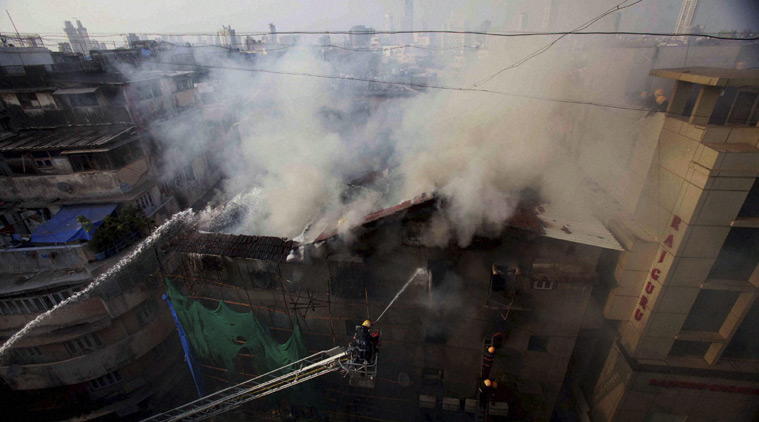Stay updated with the latest - Click here to follow us on Instagram
Virtual tinderboxes: Mumbai’s buildings have a serious fire safety deficit, says experts
Most experts have pointed out lack of disaster management planning, and also blamed lack of awareness and training among residents to combat emergencies.
 Initial clues suggest that short-circuit caused the fire that was aggravated by cylinder blast and combustible materials.
Initial clues suggest that short-circuit caused the fire that was aggravated by cylinder blast and combustible materials.
BY TANUSHREE VENKATRAMAN AND MUSAB QAZI
With the recent Kalbadevi incident, where a building collapsed following a massive blaze, highlighting the issue of lack of fire safety mechanisms for old, dilapidated structures in the city, experts have said there are several schools, hospitals, highrises and malls too that continue to flout fire safety norms.
Pointing out the lack of disaster management planning undertaken by these institutions, the experts have also blamed lack of awareness and training among people to combat such emergencies.
[related-post]
V B Sant, Director General of the National Security Council, said, “Schools, malls and hospitals face a similar risk like old structures. Of all the audits that we have carried out in some of these institutions, we have found that the escape routes are always closed. This is a risk not only in case of fire but other disasters like earthquakes and floods too.” Sant also emphasised on inclusion of disaster preparedness as a subject for primary school students in all schools. “There is so much panic created that most of the times the higher number of casualties is because of a stampede. People need to be trained,” he said.
Though the BMC had made a disaster management plan mandatory for schools following the terrorist attack at the Army School in Peshawar, Pakistan, not all have complied till date.
An official said, “A disaster management plan is the most essential for any structure but it is just not followed. The plan should include a headcount of the number of people, emergency routes in the building, medical emergency kit and the plan of the structure itself. In case of the Kalbadevi incident also, the fire brigade just did not know how many people were residing in the building.”
Former chief fire officer Pratap Khargopikar said highrises were dangerous in terms of lack of fire safety. He said, “Highrises are at a highest risk. They need enhanced fire safety requirements because fire brigade ladders can’t go beyond 60 metres. But developers enjoy the extra FSI (floor space index), and hardly provide any fire fighting equipment.” After the Lotus Business Park fire incident in 2014, fire officials had blamed lack of internal fire-fighting mechanism in the 22-storey structure that led to a further delay in combating the fire.
Some experts were also of the opinion of initiating a public-private partnership to build disaster management models for the city. “Unless the corporation involves more people or undertakes more awareness drives, there won’t be a significant difference. We will keep setting committees following such incidents but the recommendations will never be implemented,” said IC Sisodia, who was part of the Merani committee. The state had constituted the Merani Committee, headed by former Public Works Department (PWD) secretary M V Merani, to analyse the security and disaster preparedness of Mumbai.
mumbai.newsline@expressindia.com







